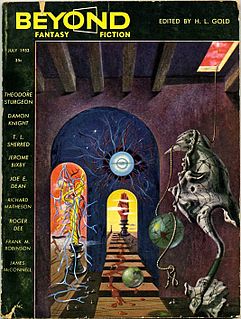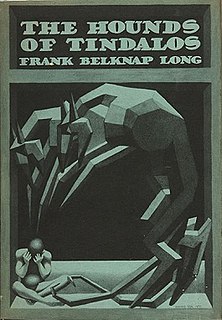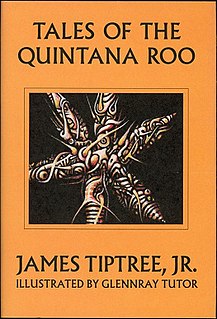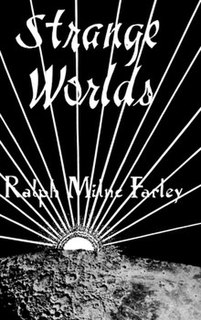
Alfred Elton van Vogt was a Canadian-born science fiction author. His fragmented, bizarre narrative style influenced later science fiction writers, notably Philip K. Dick. He was one of the most popular and influential practitioners of science fiction in the mid-twentieth century, the genre's so-called Golden Age, and one of the most complex. The Science Fiction Writers of America named him their 14th Grand Master in 1995.

John Holbrook Vance was an American mystery, fantasy, and science fiction writer. Though most of his work has been published under the name Jack Vance, he also wrote several mystery novels under pen names.
Andre Alice Norton was an American writer of science fiction and fantasy, who also wrote works of historical fiction and contemporary fiction. She wrote primarily under the pen name Andre Norton, but also under Andrew North and Allen Weston. She was the first woman to be Gandalf Grand Master of Fantasy, to be SFWA Grand Master, and to be inducted by the Science Fiction and Fantasy Hall of Fame.
This is a list of short stories by American writer Isaac Asimov. Asimov is principally known for his science fiction, but he also wrote mystery and fantasy stories.

Roger Sherman Hoar was an American state senator and assistant Attorney General, for the state of Massachusetts. He also wrote science fiction under the pseudonym of Ralph Milne Farley.

The Eyes of the Overworld is a picaresque fantasy fix-up novel by American writer Jack Vance, published by Ace in 1966, the second book in the Dying Earth series that Vance inaugurated in 1950. Retitled Cugel the Clever in its Vance Integral Edition (2005), the story takes place in Vance's Dying Earth setting, where the Sun is dying and magic and technology coexist. It features the self-proclaimed Cugel the Clever in linked episodic stories. Cugel is an anti-hero character; while he is typically a crafty scoundrel who seeks to turn a profit from a situation, he retains some good values at times. In the novel, Cugel is caught stealing from a wizard, who forces Cugel to travel to a faraway realm to find a rare magical jewel.

The Ship Who Sang (1969) is a science fiction novel by American writer Anne McCaffrey, a fix-up of five stories published 1961 to 1969. By an alternate reckoning, "The Ship Who Sang" is the earliest of the stories, a novelette, which became the first chapter of the book. Finally, the entire "Brain & Brawn Ship series", written by McCaffrey and others, is sometimes called the "Ship Who Sang series" by bibliographers, merchants, or fans.

The Black Flame is a post-apocalyptic science fiction novel by American writer Stanley G. Weinbaum, originally published in hardcover by Fantasy Press in 1948.

Beyond Fantasy Fiction was a US fantasy fiction magazine edited by H. L. Gold, with only ten issues published from 1953 to 1955. The last two issues carried the cover title of Beyond Fiction, but the publication's name for copyright purposes remained as before.

Out of Space and Time is a collection of fantasy, horror and science fiction short stories by American writer Clark Ashton Smith. It was released in 1942 and was the third book published by Arkham House. 1,054 copies were printed. A British hardcover appeared from Neville Spearman in 1971, with a two-volume paperback reprint following from Panther Books in 1974. Bison Books issued a trade paperback edition in 2006.

The Hounds of Tindalos is a collection of fantasy, horror and science fiction short stories by American writer Frank Belknap Long. It was released in 1946 and was the author's third book. It was published by Arkham House in an edition of 2,602 copies with cover art by Hannes Bok. A British hardcover was issued by Museum Press in 1950. Belmont Books reprinted The Hounds of Tindalos in two paperback volumes, The Hounds of Tindalos (1963) and The Dark Beasts (1964), omitting three stories; Panther Books issued a complete two-volume British paperback edition as The Hounds of Tindalos (1975) and The Black Druid (1975).

Tales of the Quintana Roo is a collection of fantasy stories by American author Alice Sheldon, writing as James Tiptree Jr. It was released in 1986 and was the author's first book published by Arkham House. It was published in an edition of 3,673 copies. The stories originally appeared in Isaac Asimov's Science Fiction Magazine and The Magazine of Fantasy & Science Fiction and are set in the easternmost shore of the Yucatán Peninsula in Mexico. In addition to winning the world fantasy award for best collection in 1987, each of the stories was nominated or won genre awards, and "What Came Ashore at Lirios" was included in the Oxford Book of Fantasy Stories.

The Jaguar Hunter is a collection of science fiction, fantasy and horror stories by American author Lucius Shepard. Illustrated by J. K. Potter, it was released in May, 1987 and was the author's first book published by Arkham House. It was originally published in an edition of 3,194 copies, with a second printing later in 1987 of 1,508 copies. Bantam Books issued a trade paperback edition in 1989, and Four Walls Eight Windows reprinted the collection in 2001. The first British publication came as a Paladin Books trade paperback in 1988, followed quickly by a Kerosina Books hardcover. A Rumanian translation appeared in 2008.

Beyond Time and Space is an anthology of science fiction stories edited by American writer August Derleth. It was first published by Pellegrini & Cudahy in 1950. Several of the stories had originally appeared in the magazines The Century, The Atlantic Monthly, The Strand, Blue Book, Blackwood's Magazine, Weird Tales, Amazing Stories, Astounding Stories, Maclean's, The American Legion Magazine and Startling Stories. A heavily abridged paperback edition was issued by Berkley Books in 1958.

The Moon Is Hell! is a collection of science fiction stories by American writer John W. Campbell Jr. It was published in 1950 by Fantasy Press in an edition of 4,206 copies. The title story deals with a team of scientists stranded on the Moon when their spacecraft crashes, and how they use their combined skills and knowledge to survive until rescue, including building shelter from meteor showers, and creating their own oxygen from Lunar rock. The second story, "The Elder Gods", Campbell rewrote, on a short deadline, from a story by Arthur J. Burks purchased for Unknown but later deemed unsatisfactory. It originally appeared in that magazine under the pseudonym Don A. Stuart. The title of the eponymous story is generally reported without the exclamation point, although the punctuation is used for the title of most editions of the collection itself.
William Levi Crawford was an American publisher and editor.

The Hidden Universe is a collection of two science fiction novellas by American writer Ralph Milne Farley. It was first published in 1950 by Fantasy Publishing Company, Inc. in an edition of 700 copies of which 500 were hardback. The novellas originally appeared in the magazine Amazing Stories.

Strange Worlds is a collection of science fiction by Ralph Milne Farley. Consisting of one novel and two shorter novellas, it was first published in 1953 by Fantasy Publishing Company, Inc. in an edition of 300 copies. The book is an omnibus of Farley's earlier books, The Radio Man and The Hidden Universe. The novel was originally serialized in the magazine Argosy and the novellas originally appeared in the magazine Amazing Stories.

Satellite Science Fiction was an American science-fiction magazine published from October 1956 to April 1959 by Leo Margulies' Renown Publications. Initially, Satellite was digest sized and ran a full-length novel in each issue with a handful of short stories accompanying it. The policy was intended to help it compete against paperbacks, which were taking a growing share of the market. Sam Merwin edited the first two issues; Margulies took over when Merwin left and then hired Frank Belknap Long for the February 1959 issue. That issue saw the format change to letter size, in the hope that the magazine would be more prominent on newsstands. The experiment was a failure and Margulies closed the magazine when the sales figures came in.
Lafayette Ronald Hubbard, better known as L. Ron Hubbard, was an American pulp fiction author. He wrote in a wide variety of genres, including science fiction, fantasy, adventure fiction, aviation, travel, mystery, western, and romance. His United States publisher and distributor is Galaxy Press. He is perhaps best known for his self-help book, the #1 New York Times bestseller Dianetics: The Modern Science of Mental Health, and as the founder of the Church of Scientology.
















